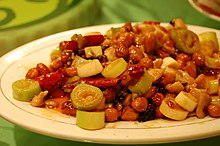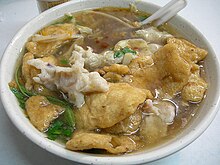Chinese regional cuisine

| Part on a series on |
| Chinese cuisine |
|---|
 |
|
Chinese regional cuisines are the different cuisines found in different provinces and prefectures of China as well as from larger Chinese communities overseas.
A number of different styles contribute to Chinese cuisine but perhaps the best known and most influential are Cantonese cuisine, Shandong cuisine, Jiangsu cuisine (specifically Huaiyang cuisine) and Szechuan cuisine.[1][2] These styles are distinctive from one another due to factors such as availability of resources, climate, geography, history, cooking techniques and lifestyle.[3] One style may favour the generous use of garlic and shallots over chilli and spices, while another may favour preparing seafood over other meats and fowl.
Jiangsu cuisine favours cooking techniques such as braising and stewing, while Sichuan cuisine employs baking, just to name a few.[1] Hairy crab is a highly sought after local delicacy in Shanghai, as it can be found in lakes within the region. Peking duck and dim-sum are other popular dishes well known outside of China.[1]
Based on the raw materials and ingredients used, the method of preparation and cultural differences, a variety of foods with different flavors and textures are prepared in different regions of the country. Many traditional regional cuisines rely on basic methods of preservation such as drying, salting, pickling and fermentation.[4]
Eight Great Traditions[]
Historically, the Four Great Traditions (Chinese: 四大菜系; pinyin: Sìdà càixì) of Chinese cuisine are Chuan, Lu, Yue and Huaiyang, representing West, North, South and East China cuisine correspondingly.[5] However, in modern times the list is often expanded to the Eight Great Traditions (Chinese: 八大菜系; pinyin: Bādà càixì), which are as follows:
Cantonese[]

Cantonese cuisine (Chinese: 粤菜; pinyin: yuècài) is a regional cuisine that emphasises the minimal use of sauce which brings out the original taste of food itself.[6] It is known for dim sum, a Cantonese term for small hearty dishes, which became popular in Hong Kong in the early 20th Century.[1][7] These bite-sized portions are prepared using traditional cooking methods such as frying, steaming, stewing and baking. It is designed so that one person may taste a variety of different dishes. Some of these may include rice rolls, lotus leaf rice, turnip cakes, buns, jiaozi-style dumplings, stir-fried green vegetables, congee porridge, soups, etc. The Cantonese style of dining, yum cha, combines the variety of dim sum dishes with the drinking of tea. Yum cha literally means "drink tea".[1]
Sichuan[]

Sichuan cuisine (Chinese: 川菜; pinyin: chuāncài; spelled Szechuan or Szechwan in the once-common postal romanization) is a style of Chinese cuisine originating from the Sichuan Province of southwestern China, famed for bold flavors, particularly the pungency and spiciness resulting from liberal use of garlic and chili peppers, as well as the unique flavor of the Sichuan peppercorn (花椒; huājiāo) and Facing heaven pepper (朝天椒; cháotiān jiāo). Peanuts, sesame paste and ginger are also prominent ingredients in this style.
Anhui[]
Anhui cuisine (徽菜; huīcài or 徽州菜; huīzhōu cài) is derived from the native cooking styles of the Huangshan Mountains region in China and is similar to Jiangsu cuisine, but with less emphasis on seafood and more on a wide variety of local herbs and vegetables. Anhui province is particularly endowed with fresh bamboo and mushroom crops.
Shandong[]

This section's tone or style may not reflect the encyclopedic tone used on Wikipedia. (January 2015) |
Shandong cuisine[8] (鲁菜; lǔcài) is commonly known as Lu cuisine.[9] Shandong cuisine made one of the most important parts of imperial cuisine with wide distribution across North China. Lu cuisine dishes are noted for having fresh, salty, crisp and tender features. Lu cuisine chefs are experienced to care for the seasoning of clear broth and creamy soup. It was recorded to be highly favored by the imperial family in the Ming and Qing dynasty. Shandong cuisine features a variety of cooking techniques and seafood ingredients. Typical dishes on local menus include braised abalone, braised sea cucumbers, sweet and sour carp, braised pork intestines and Dezhou chicken (marinated chicken originating from the city of Dezhou).
Fujian[]

Fujian (Hokkien) cuisine (闽菜; mǐncài) is influenced by Fujian's coastal position and mountainous terrain.[10] Woodland delicacies such as edible mushrooms and bamboo shoots are also utilized.[10] Slicing techniques are valued in the cuisine and utilized to enhance the flavor, aroma and texture of seafood and other foods.[10] Fujian cuisine is often served in a broth or soup, with cooking techniques including braising, stewing, steaming and boiling.[10]
Jiangsu[]
Jiangsu cuisine (淮扬菜; huáiyángcài) is one of the major components of Chinese cuisine, which consists of the styles of Huai'an, Yangzhou, Nanjing, Suzhou and Zhenjiang dishes. It is especially popular in the lower reach of the Yangtze River. Huaiyang cuisine, one of the Four Great Traditions, is a style of Jiangsu cuisine.
Typical courses of Jiangsu cuisine are Jinling salted dried duck (Nanjing's most famous dish), crystal meat (pork heels in a bright, brown sauce), clear crab shell meatballs (pork meatballs in crab shell powder, fatty, yet fresh), Yangzhou steamed jerky strips (dried tofu, chicken, ham and pea leaves), triple combo duck, dried duck, Farewell My Concubine (soft-shelled turtle stewed with many other ingredients such as chicken, mushrooms and wine), and sweet and sour mandarin fish (Suzhou cuisine).
Hunan[]

Hunan cuisine (湘菜; Xiāngcài) is well known for its hot spicy flavor,[11] fresh aroma and deep color. Common cooking techniques include stewing, stir-frying, pot-roasting, braising, and smoking. Due to the high agricultural output of the region, there are many varied ingredients for Hunan dishes. Hunan cuisine is called Xiāngcài in China, because the abbreviation of Hunan Province is Xiāng (湘). Some typical dishes of Hunan Cuisine are steaming smoked meat, stew fish, rice noodle soup. Besides spicy, Hunan cuisine, especially western Hunan, also emphasizes on sourness. Therefore, different kinds of pickles are popular in Hunan, for example, Douchi is a type of fermented and salted black soybean.'
Zhejiang[]
Zhejiang cuisine (浙菜; Zhècài or 浙江菜; zhèjiāngcài) derives from the native cooking styles of the Zhejiang region. The dishes are not greasy, having instead a fresh, soft flavor with a mellow fragrance.
The cuisine consists of at least four styles, each of which originated from different cities in the province:
- Hangzhou style, characterized by rich variations and the use of bamboo shoots
- Shaoxing style, specializing in poultry and freshwater fish
- Ningbo style, specializing in seafood
- Shanghai style, a combination of different Zhe styles, is also very famous for its dim sum
Other[]
This section needs expansion. You can help by . (April 2013) |
Many other regions and ethnic groups with unique dishes and styles are represented in China, including Macau, Taiwan, and many more.
Dong Bei[]
Many dishes in this region originated in Manchu cuisine, but it is also heavily influenced by the cuisines of Russia, Beijing, Mongolia, and Shandong. It partially relies on preserved foods and large portions due to the region's harsh winters and relatively short growing seasons.
Hainan[]
Hainan cuisine is derived from the cooking styles of the peoples of Hainan Province in China. The food is lighter, less oily, and more mildly seasoned than that of the Chinese mainland. Seafood predominates the menu, as prawn, crab, and freshwater and ocean fish are widely available.
Hakka[]

Hakka cuisine is the cooking style of the Hakka people, and it may also be found in parts of Taiwan and in countries with significant overseas Hakka communities. It emphasizes the texture of food, and features preserved meats and vegetables.
Mongolian[]
Mongolian hotpot is very famous in China, and popular with the Han ethnic group too.
Tibetan[]
Tibetan cuisine is traditionally served with bamboo chopsticks, in contrast to other Himalayan cuisines, which are eaten by hand. Small soup bowls are used, and the wealthier Tibetans ate from bowls of gold and silver.
Xinjiang[]
The cuisine of Xinjiang reflects the region's many ethnic groups, and refers particularly to Uyghur cuisine. Signature ingredients include roasted mutton, kebabs, roasted fish and rice. Because of the distinctive Muslim population, the food is predominantly halal.
Yunnan[]
Yunnan only began to come under significant Chinese influence some 1000 years after Sichuan was annexed. As the most geographically, ethnically and culturally diverse province in modern China, it naturally features a wide variety of cuisine.
References[]
- ^ Jump up to: a b c d e Yao, Zhang. China Everyday!. Page One Pub. 2007. ISBN 978-981-245-330-3
- ^ "Regions of Chinese food-styles/flavors of cooking." University of Kansas, Kansas Asia Scholars. Accessed June 2011.
- ^ "China's Culinary Diversity in One Map"
- ^ J. Li & Y. Hsieh. Traditional Chinese Food Technology and Cuisine. Asia Pacific Journal of Clinical Nutrition.
- ^ "Four Major Cuisines in China". CITS. Retrieved 10 January 2017.
- ^ Editorial Team of Hong Kong Economic Journal. "舌尖上的中國:八大菜系由來 [The Taste of China: The Origin of Eight Great Traditions]". Hong Kong Economic Journal.
- ^ K K News (2 February 2018). "港式點心之前世今生 [The History of Dim Sum in Hong Kong Style]".
- ^ "Shandong Cuisine".
- ^ "Lu cuisine".
- ^ Jump up to: a b c d "Fujian Cuisine. Archived 2013-07-31 at the Wayback Machine Beautyfujian.com Archived 2011-07-10 at the Wayback Machine. Accessed June 2011.
- ^ "Hunan Cuisine." China.org, Chinese Imperial Cuisines. Accessed June 2011.
- Regional cuisines of China
